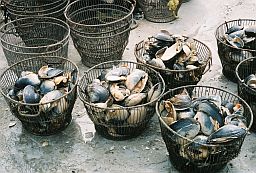Research: Atlantic Surf Clam (Spisula solidissima) & Ocean Quahog (Arctica islandica)
 The Atlantic surf clam (Spisula solidissima) and the ocean quahog (Arctica islandica) are benthic dominant infaunal clams on the Georges Bank, Southern New England Shelf, and Mid Atlantic Bight. Surf clams are found from the subtidal to approximately 25m depth, while ocean quahogs extend from 25m to deeper waters. The distributions are separated by the intersection of an intense seasonal thermocline with the bottom in the summer months. Surf clams are among the largest clams in the world that do not harbor symbionts and live “inshore” of the cold water pool. Ocean quahogs are among the longest-lived animals in the world (approaching 400 years) and live in the cold water pool. Indeed ocean quahogs are an Arctic-Boreal species whose distribution continues north through the Gulf of Maine, across the Atlantic including the waters surrounding Iceland, to the northern European shelf and into the Barents and
The Atlantic surf clam (Spisula solidissima) and the ocean quahog (Arctica islandica) are benthic dominant infaunal clams on the Georges Bank, Southern New England Shelf, and Mid Atlantic Bight. Surf clams are found from the subtidal to approximately 25m depth, while ocean quahogs extend from 25m to deeper waters. The distributions are separated by the intersection of an intense seasonal thermocline with the bottom in the summer months. Surf clams are among the largest clams in the world that do not harbor symbionts and live “inshore” of the cold water pool. Ocean quahogs are among the longest-lived animals in the world (approaching 400 years) and live in the cold water pool. Indeed ocean quahogs are an Arctic-Boreal species whose distribution continues north through the Gulf of Maine, across the Atlantic including the waters surrounding Iceland, to the northern European shelf and into the Barents and
-
Stock assessment - Both surf clams and ocean quahogs support major offshore fisheries.
-
Age determination, demography and climate change - Given that biology of both species is temperature sensitive both are useful barometers of climate change impacts on Atlantic shelf dwelling species.
-
Interdisciplinary modeling work - This project is focused on understanding how climate forcing affects an exploited benthic dominant species in the mid-Atlantic, the surf clam (Spisula solidissima) and with human components of the system.
Related Links
- Publications for Atlantic Surf Clam (Spissula solidissima) and Ocean Quahog (Arctica islandica)

